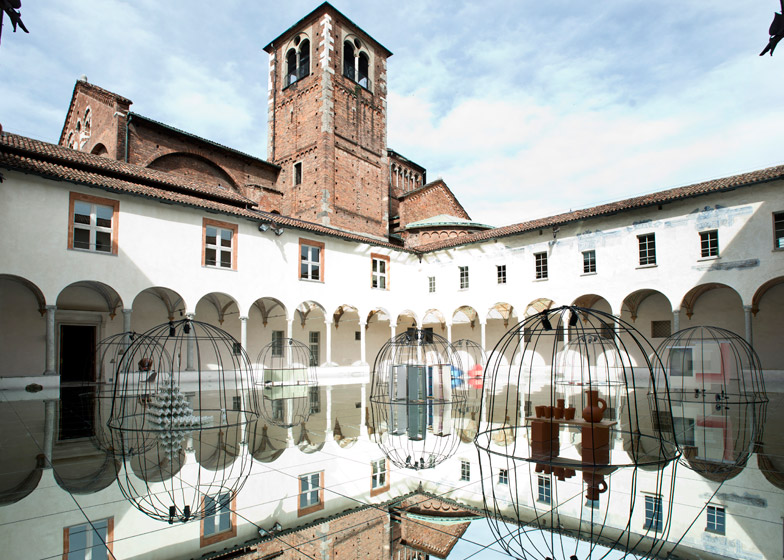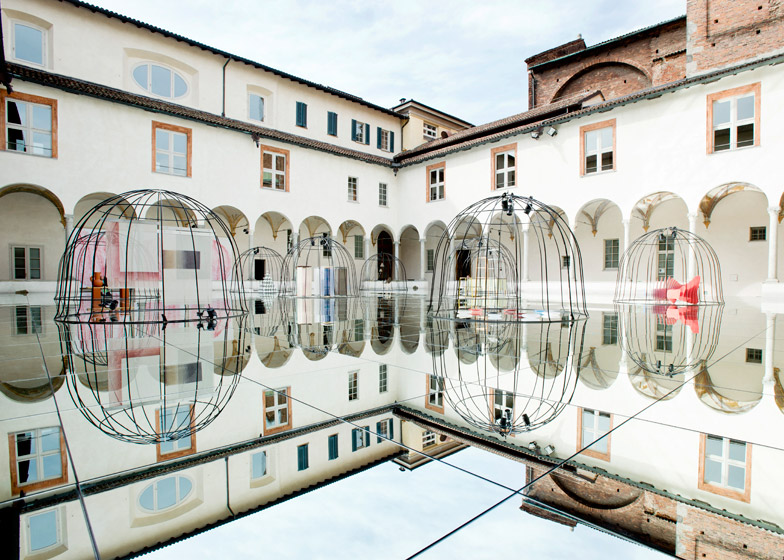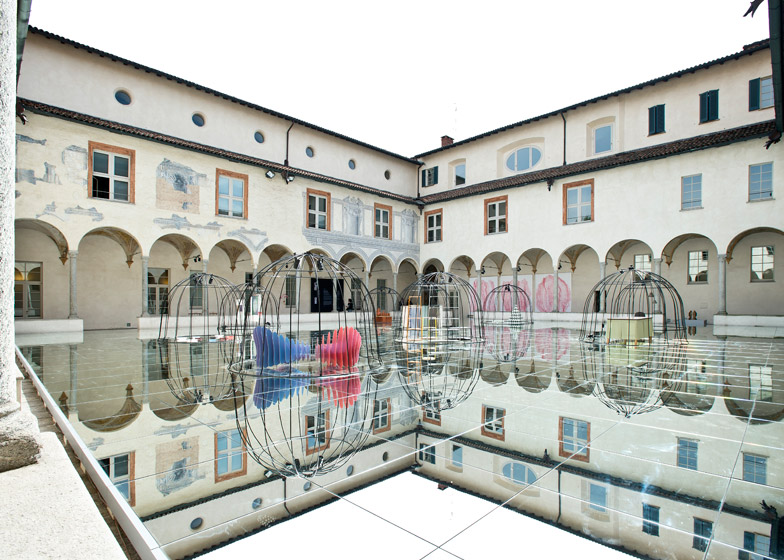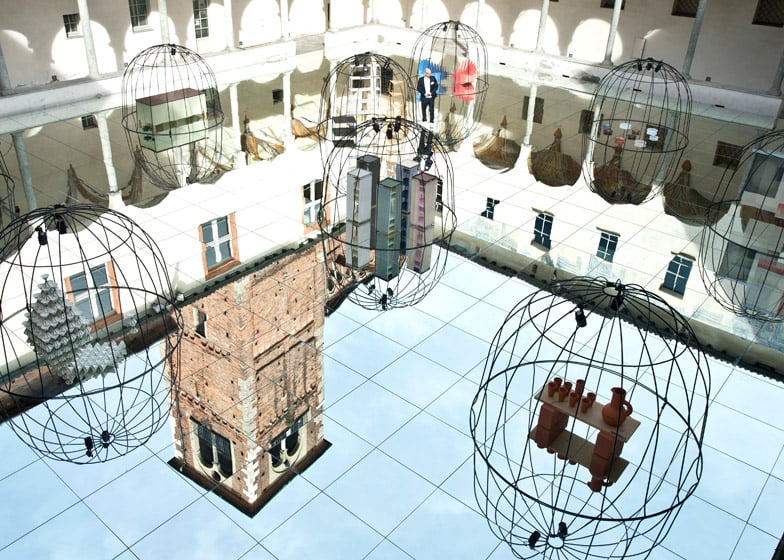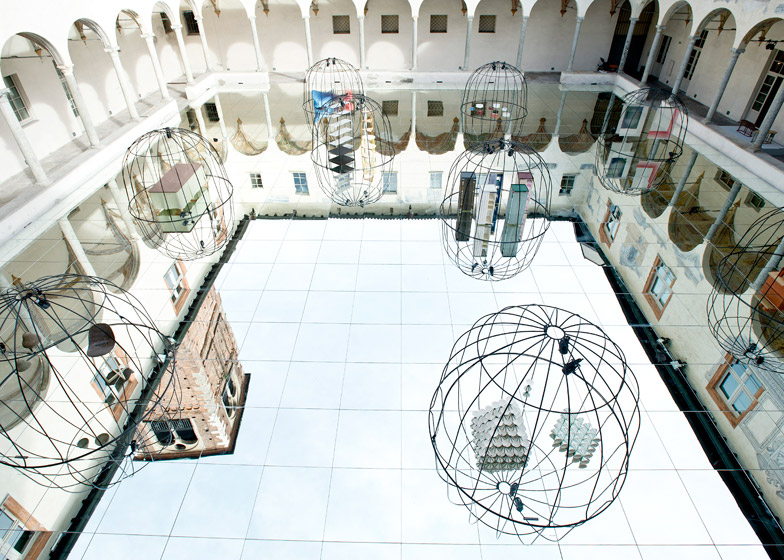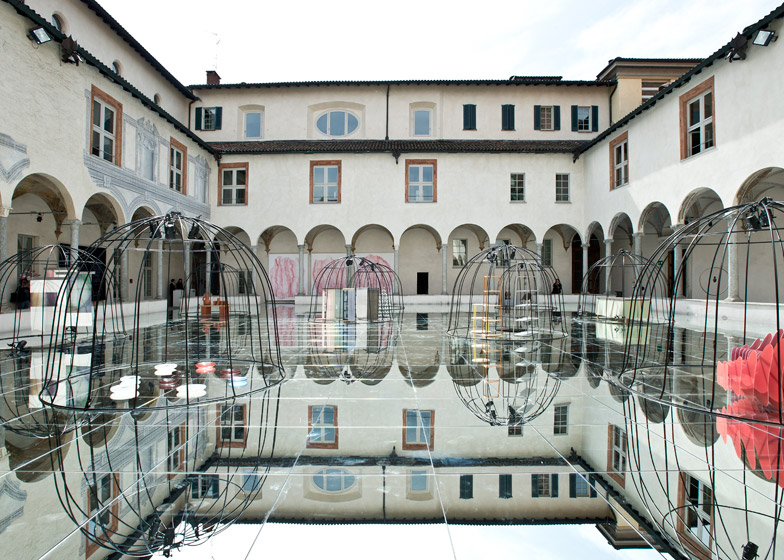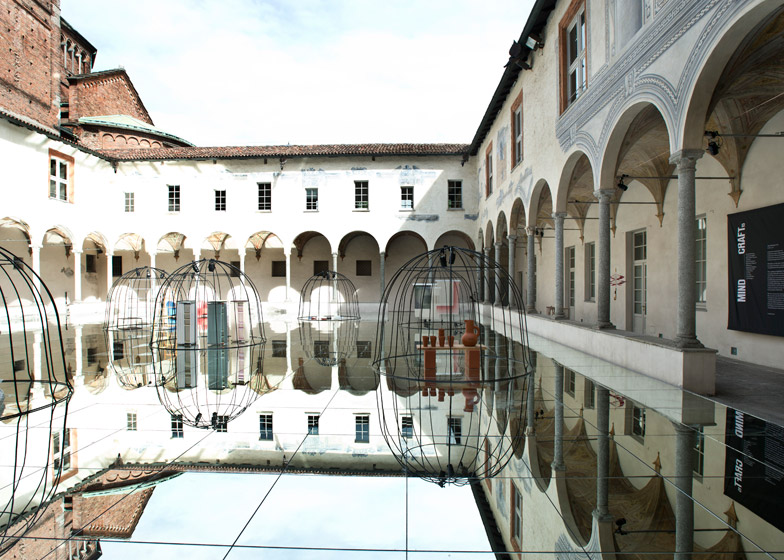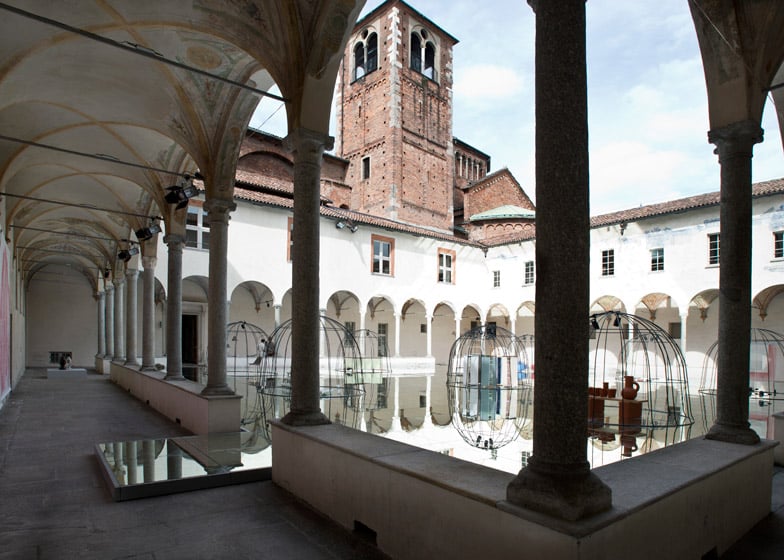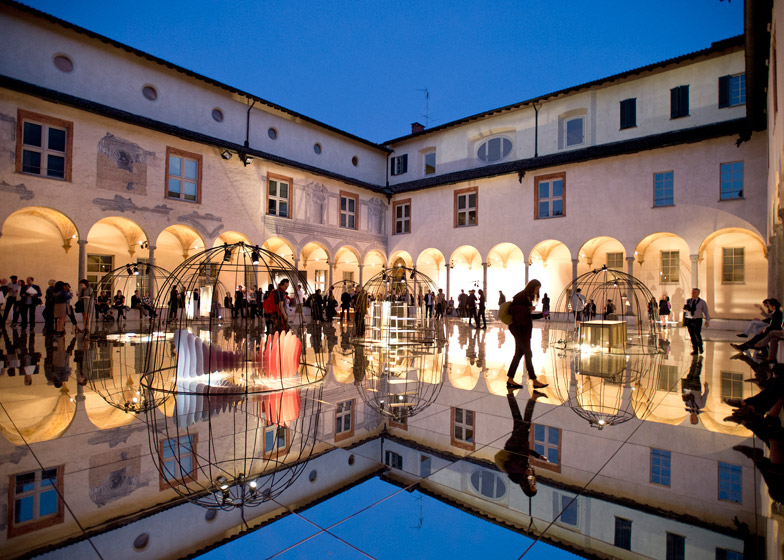Milan 2015: design duo GamFratesi recruited established names like Cecilie Manz and Ole Jensen to exhibit alongside new designers in a mirrored installation for the Mindcraft exhibition in Milan.
Mindcraft is an annual showcase of Danish design that takes place in Milan during the design week. Previously located in the Ventura Lambrate district, for 2015 the show has moved to a new venue – Chiostro Minore di San Simpliciano, a historic religious cloister in the Brera district of the city.
This year's curators, Danish and Italian design duo Stine Gam and Enrico Fratesi, have covered the floor of the courtyard in the middle of the cloister with mirrors supported on a temporary platform.
The pair commissioned 14 designers and artists to create new pieces for the exhibition on the theme "In Between". These are housed inside black metal cages on top of the mirrored floor or hung from temporary supports in the covered walkways that wrap around the space.
Rosa Tolnov Clausen, a recent graduate of Design School Kolding, created three woven wall hangings that reinterpret traditional techniques with modern materials to make them suitable for outdoor use.
Made from polyester, the threads have aluminium and polyester cores to helps them hold their shape. The woven pieces are coloured using spray paint to create different optical effects.
"I wanted to work with the transparency so that you could sense people behind it," Tolnov told Dezeen.
"I always work with Scandinavian weaving traditions and craft," she explained. "I am very occupied with how we preserve these techniques and develop them so that they keep having a relevance."
Ole Jensen – one of Denmark's most successful ceramicists and designers, whose work is produced by brands including Normann Copenhagen, Muuto and Royal Copenhagen – created a set of cups with a matching jug designed for serving water.
Called The Basic Bar, the set rests on a simple pine plinth and is made from red clay treated to look like unglazed terracotta that references vessels used in ancient history. The chemical symbol for water, H20, is sprayed onto the side of the jug in black ink.
Jensen told Dezeen that the project was part of his interest in creating objects that explore ideas of "ordinary" design.
"Usually when you are going to do something for a fair or exhibition you think 'I would like to do something new'. This year I decided no, it's not necessary to do something new but maybe you can do something as a kind of statement – looking back into history," said Jensen.
Copenhagen-based Japanese furniture designer Akiko Kuwohata chose to make a portable table from layered strips of walnut, oak and dyed birch wood veneer, with a shape based on a traditional tram carriage.
"I got idea from the old city train, with beautiful details and organic forms," Kuwohata told Dezeen. "The table is very light so you can just take it everywhere."
The top of the table lifts off to provide a tray for serving tea and coffee, and is held in place with a handle the protrudes through the top of the design. The dyed birch wood is pressed between the natural woods, which are then moulded to create a stripy pattern throughout the design.
Cecilie Manz, one of Denmark's leading furniture designers, also designed a table for the exhibition. Called the Solid Table, the piece is almost two metres in length and is made from Oregon pine, with a dark red polished-limestone top. A skirt of fabric, described by Manz as being "matcha green" after the traditional Japanese tea, conceals the legs and is held in place by the stone top.
Ceramics specialists Karen Kjældgård-Larsen and Tine Broksø, who work together under the name Calydies, created a series of glazed forms shaped like two martini glasses stuck together that were then stacked like a champagne fountain. The mirrors on the floor reflect the stack to create a doubling effect.
"This project at one point will be something functional but now it's more like an expression or a sculpture," said Broksø.
Designers Jakob Jørgensen and Line Depping chose to work on a more practical project, creating a flexible furniture system based on sand-cast aluminium struts that can be used to support shelves of various sizes.
Fittings are integrated into the wood to make the pieces easy to assemble, and the angle of the struts creates pieces that become narrower as they go up.
The Castaway by artists Ben Clement and Sebastian de la Cour – also known as benandsebastian – made a copy of an antique Chinese carrying case for which the contents have been lost. A blown glass mould fills the void inside. The replica case was made in China as one of a series of eight pieces intended to reference traditions of mould-making and casting.
Furniture designer Christina Liljenberg Halstrøm collaborated with textile designer Margrethe Odgaard to make Pedestal – a small metal cabinet designed for displaying objects like a plinth for a bust. The steel frame of the cabinet can be flat packed, and curtains made from two layers of Trevira fabric on contrasting colours are used to disguise the contents.
Glass artist Tora Urup contributed a group of thick glass dishes with gently concaved tops and textured bottoms. Coloured glass was added to the base of each piece during the firing process to create a variety of unique textural effects when viewed through the polished surface of the top, and in the reflections in the mirrored floor.
Fashion designer Henrik Vibskov was asked to make an umbrella for the show. Although his object has a similar shape to an umbrella, and is made from the same materials, its canopy has been deconstructed to form a red and white spiral that references the double helix of a strand of DNA.
Selfie consists of two elliptical forms designed by artist Eske Rex, and carved from a single piece of wood that has been split in half. Suspended from a round wooden frame with strings, the two pieces are embedded with magnets, creating a tension that holds them in place until a gust of wind makes them rotate.
Product designer Jakob Wagner designed a curved bench made from slats of coloured acrylic – half in blue and half in red. When viewed from specific angles the object appears monochrome and solid.
Other projects include a series of three red drawings by British designer Louise Campbell, who lives in Denmark, and lamps by design duo Edvard-Steenfaat made from a material created by combining seaweed and recycled paper.
Mindcraft will be on show until 19 April at Chiostro Minore di San Simpliciano, which is accessed at Via dei Cavalieri del Santo Sepolcro 3.

